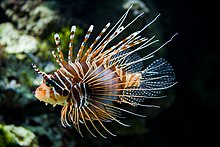A Lionfish is any of several species of venomous marine fish in the genera Pterois, Parapterois, Brachypterois, Ebosia or Dendrochirus, of the family Scorpaenidae. The lionfish is also known as the


Native environment
The lionfish is native to the Indian Pacific oceanic region. This range extends from western Australia and Malaysia east to French Polynesia and the Pitcairn Islands. In addition, the range also extends north to southern Japan and southern Korea and south to parts of coastal Australia.[2]
Although the lionfish is not native to all regions in the world, these fish continue to spread throughout many parts of the world.[3] Due to a recent introduction, the lionfish has been spotted in the warmer coral regions of the eastern Atlantic Ocean around the Azores and extending into the Mediterranean Sea, and also in the Caribbean Sea (Cozumel, Jamaica, the Dominican Republic, Belize, Roatan, and Puerto Rico as of 2010) and in the Red Sea .[4] It has been speculated that this introduction may well have been caused when Hurricane Andrew destroyed an aquarium in southern Florida.[5]. However, a more recent report [6] states that NOAA ecologist James Morris Jr. has discovered that a Lionfish was caught off Dania, FL prior to Hurricane Andrew, as long ago as 1985. Morris indicated that the "most likely vector" was release of fish and/or eggs into the wild by people in the aquarium trade. DNA from captured lionfish in this region shows that they all originated from the same six or seven fish.[7] The lion fish has also a low breeding system.[clarification needed] Pterois volitans lionfish has also been found in waters near Long Island , New York, where as a 'tropical fish', it was not expected to be able to survive.
Treatment of invasive Lionfish in the Caribbean varies - in Cozumel they are frequently captured alive in order to collect a bounty that has been placed upon them, while in Roatan they are frequently killed on sight by local divemasters, with as many as five or six killed during a single 1-hour dive.
Size
There are many types of lionfish that vary in size. The Common Lionfish, or Devil Firefish, generally reaches a size of 30 cm to 35 cm (12 inches), while smaller lionfish, like the Fuzzy Dwarf Lionfish, Dendrochirus brachypterus, are typically the size of a tennis ball, not including fins. In the Caribbean where lionfish are non-indigenous, they grow to a size of up to 55 cm.
Warnings
The NOAA encourages everyone (divers and fishers) to be extremely cautious and avoid contact with the venomous spikes of the lionfish. Usually, lionfish are not aggressive toward humans and will almost always keep their distance when given the opportunity, so they pose a relatively low risk. In addition, their stings are not deadly, but they are very painful.[8]
Venom

The lionfish is one of the most venomous fish on the ocean floor. Lionfish have venomous dorsal spines that are used purely for defense. When threatened, the fish often faces its attacker in an upside down posture which brings its spines to bear. However, a lionfish's sting is usually not fatal to humans. If a human is envenomed, that person will experience extreme pain, and possibly headaches, vomiting, and breathing difficulties. A common treatment is soaking the afflicted area in hot water, as very few hospitals carry specific treatments.[9][10][11] However, immediate emergency medical treatment is still advised, as some people are more susceptible to the venom than others.
Feeding
Lionfish are voracious predators. They do not use their spines to capture prey; only for protection from their own predators. When hunting, they corner prey using their large fins and then use their quick reflexes to swallow the prey whole. They hunt primarily from late afternoon to dawn. In captivity, lionfish can be trained to eat frozen krill and mysis.
Predators
The lionfish have very few natural predators, but the grouper and other fish have been found with lionfish remains in their stomachs.
 RSS Feed
RSS Feed Twitter
Twitter 9:06 PM
9:06 PM
 Your All Kinds Of Need At One Place
Your All Kinds Of Need At One Place
0 comments:
Post a Comment